1. Guo Y, Lin H, Shi Y, Zheng Y, Li X, Xiao J, et al. Long-term exposure to ambient PM
2.5 associated with fall-related injury in six low- and middle-income countries. Environ Pollut. 2018; 237:961–967. PMID:
29128246.
2. James SL, Lucchesi LR, Bisignano C, Castle CD, Dingels ZV, Fox JT, et al. The global burden of falls: global, regional and national estimates of morbidity and mortality from the Global Burden of Disease Study 2017. Inj Prev. 2020; 26(Supp 1):i3–11. PMID:
31941758.
3. Kim YE, Park H, Jo MW, Oh IH, Go DS, Jung J, et al. Trends and patterns of burden of disease and injuries in Korea using disability-adjusted life years. J Korean Med Sci. 2019; 34(Suppl 1):e75. PMID:
30923488.
4. Ambrose AF, Paul G, Hausdorff JM. Risk factors for falls among older adults: a review of the literature. Maturitas. 2013; 75(1):51–61. PMID:
23523272.
5. World Health Organization. Ambient (Outdoor) Air Pollution. Geneva, Switzerland: World Health Organization;2021.
6. Kim KH, Kabir E, Kabir S. A review on the human health impact of airborne particulate matter. Environ Int. 2015; 74:136–143. PMID:
25454230.
7. Shin J, Han SH, Choi J. Exposure to ambient air pollution and cognitive impairment in community-dwelling older adults: the Korean Frailty and Aging Cohort Study. Int J Environ Res Public Health. 2019; 16(19):3767. PMID:
31591354.
8. Scapellato ML, Lotti M. Short-term effects of particulate matter: an inflammatory mechanism? Crit Rev Toxicol. 2007; 37(6):461–487. PMID:
17661213.
9. Merlo J, Wagner P, Leckie G. A simple multilevel approach for analysing geographical inequalities in public health reports: the case of municipality differences in obesity. Health Place. 2019; 58:102145. PMID:
31195211.
10. Oh TK, Song IA. Exposure to air pollution and risk of hip fracture: a population-based cohort study with a 6-year follow-up in South Korea. J Occup Environ Med. 2020; 62(12):1034–1039. PMID:
33065728.
11. Ha KH, Cho J, Cho SK, Kim C, Shin DC. Air pollution and unintentional injury deaths in South Korea. Environ Sci Pollut Res Int. 2015; 22(10):7873–7881. PMID:
25598159.
12. Kang YW, Ko YS, Kim YJ, Sung KM, Kim HJ, Choi HY, et al. Korea community health survey data profiles. Osong Public Health Res Perspect. 2015; 6(3):211–217. PMID:
26430619.
13. Obesity: preventing and managing the global epidemic. Report of a WHO consultation. World Health Organ Tech Rep Ser. 2000; 894:i–ixii. PMID:
11234459.
14. Kim E, Shin MH, Yang JH, Ahn SK, Na BJ, Nam HS. Associations of regional-level perceived stress and depression with health-related quality of life in Korean adults: a multilevel analysis of 2017 Korea Community Health Survey data. Epidemiol Health. 2021; 43:e2021062. PMID:
34525500.
15. Austin PC, Merlo J. Intermediate and advanced topics in multilevel logistic regression analysis. Stat Med. 2017; 36(20):3257–3277. PMID:
28543517.
16. Talbot LA, Musiol RJ, Witham EK, Metter EJ. Falls in young, middle-aged and older community dwelling adults: perceived cause, environmental factors and injury. BMC Public Health. 2005; 5(1):86. PMID:
16109159.
17. Kelsey JL, Berry SD, Procter-Gray E, Quach L, Nguyen US, Li W, et al. Indoor and outdoor falls in older adults are different: the maintenance of balance, independent living, intellect, and Zest in the Elderly of Boston Study. J Am Geriatr Soc. 2010; 58(11):2135–2141. PMID:
20831726.
18. Fischer P, Hoek G, Brunekreef B, Verhoeff A, van Wijnen J. Air pollution and mortality in The Netherlands: are the elderly more at risk? Eur Respir J Suppl. 2003; 40:34s–38s. PMID:
12762572.
19. Kaufman JD, Adar SD, Barr RG, Budoff M, Burke GL, Curl CL, et al. Association between air pollution and coronary artery calcification within six metropolitan areas in the USA (the Multi-Ethnic Study of Atherosclerosis and Air Pollution): a longitudinal cohort study. Lancet. 2016; 388(10045):696–704. PMID:
27233746.
20. Adar SD, Klein R, Klein BE, Szpiro AA, Cotch MF, Wong TY, et al. Air Pollution and the microvasculature: a cross-sectional assessment of in vivo retinal images in the population-based multi-ethnic study of atherosclerosis (MESA). PLoS Med. 2010; 7(11):e1000372. PMID:
21152417.
21. Łatka P, Nowakowska D, Nowomiejska K, Rejdak R. How air pollution affects the eyes — a review. Ophthalmology Journal. 2018; 3(2):58–62.
22. Loane C, Pilinis C, Lekkas TD, Politis M. Ambient particulate matter and its potential neurological consequences. Rev Neurosci. 2013; 24(3):323–335. PMID:
23612538.
23. Liu H, Hu T. Impact of socioeconomic status and health risk on fall inequality among older adults. Health Soc Care Community. 2022.
24. Choi KC, Kim SA, Kim NR, Shin MH. Association between smoking and unintentional injuries among Korean adults. Chonnam Med J. 2018; 54(3):184–189. PMID:
30288375.
25. Ogliari G, Ryg J, Andersen-Ranberg K, Scheel-Hincke LL, Masud T. Association between body mass index and falls in community-dwelling men and women: a prospective, multinational study in the Survey of Health, Ageing and Retirement in Europe (SHARE). Eur Geriatr Med. 2021; 12(4):837–849. PMID:
33817765.
26. Trevisan C, Ripamonti E, Grande G, Triolo F, Ek S, Maggi S, et al. The association between injurious falls and older adults’ cognitive function: the role of depressive mood and physical performance. J Gerontol A Biol Sci Med Sci. 2021; 76(9):1699–1706. PMID:
33649763.
27. Vinik AI, Camacho P, Reddy S, Valencia WM, Trence D, Matsumoto AM, et al. Aging, diabetes, and falls. Endocr Pract. 2017; 23(9):1117–1139. PMID:
28704101.
28. Klein D, Nagel G, Kleiner A, Ulmer H, Rehberger B, Concin H, et al. Blood pressure and falls in community-dwelling people aged 60 years and older in the VHM&PP cohort. BMC Geriatr. 2013; 13(1):50. PMID:
23692779.
29. Ortolá R, García-Esquinas E, Galán I, Guallar-Castillón P, López-García E, Banegas JR, et al. Patterns of alcohol consumption and risk of falls in older adults: a prospective cohort study. Osteoporos Int. 2017; 28(11):3143–3152. PMID:
28725986.
30. Chen CM, Yoon YH. Usual alcohol consumption and risks for nonfatal fall injuries in the United States: results from the 2004–2013 National Health Interview Survey. Subst Use Misuse. 2017; 52(9):1120–1132. PMID:
28524713.
31. Zhang Z, Liu J, Wu Y, Yan G, Zhu L, Yu X. Multi-scale comparison of the fine particle removal capacity of urban forests and wetlands. Sci Rep. 2017; 7(1):46214. PMID:
28393900.
32. Monn C. Exposure assessment of air pollutants: a review on spatial heterogeneity and indoor/outdoor/personal exposure to suspended particulate matter, nitrogen dioxide and ozone. Atmos Environ. 2001; 35(1):1–32.
33. Vardell E. Global health observatory data repository. Med Ref Serv Q. 2020; 39(1):67–74. PMID:
32069199.
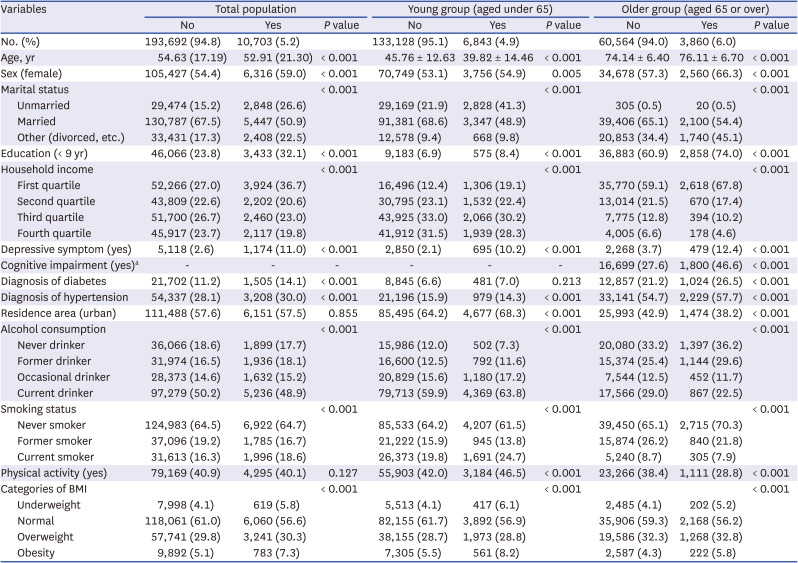
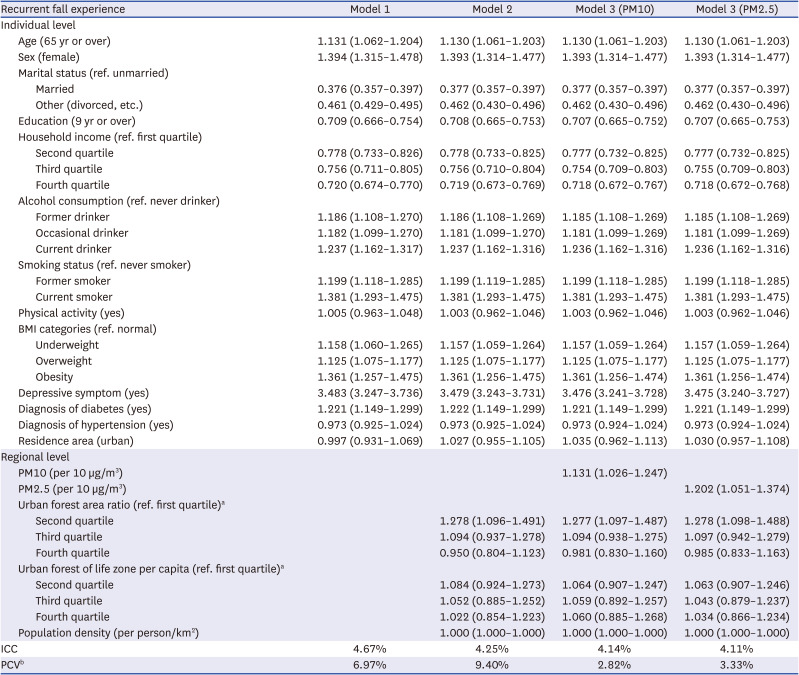
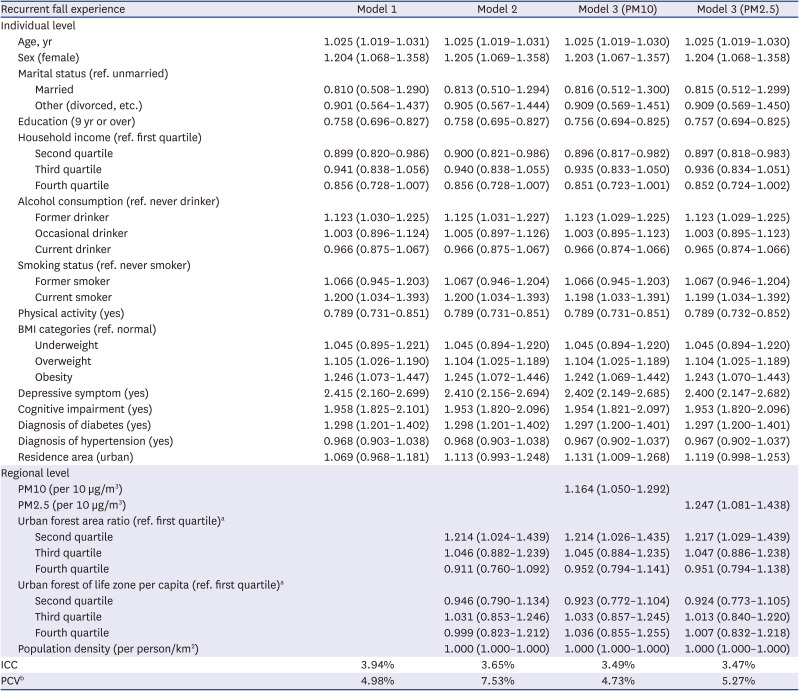
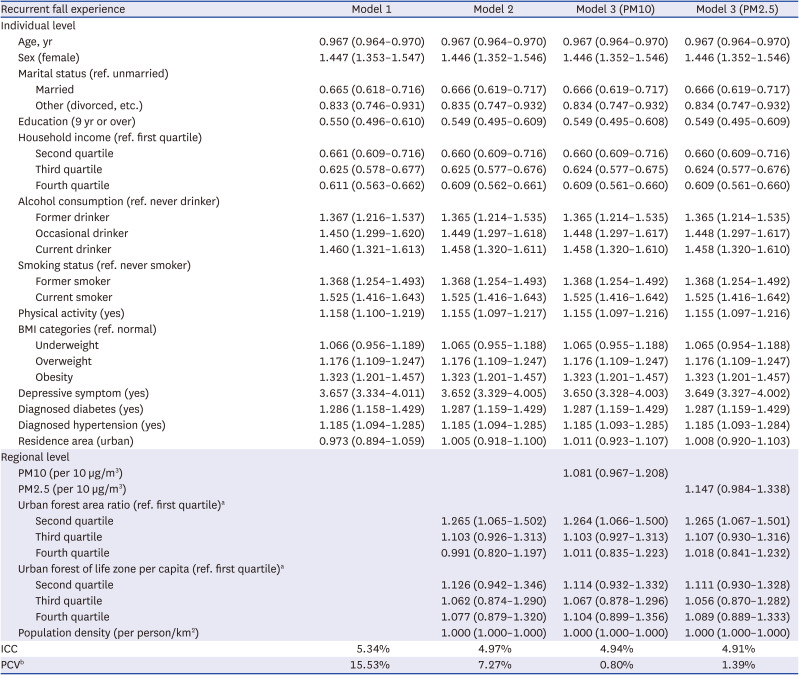




 PDF
PDF Citation
Citation Print
Print



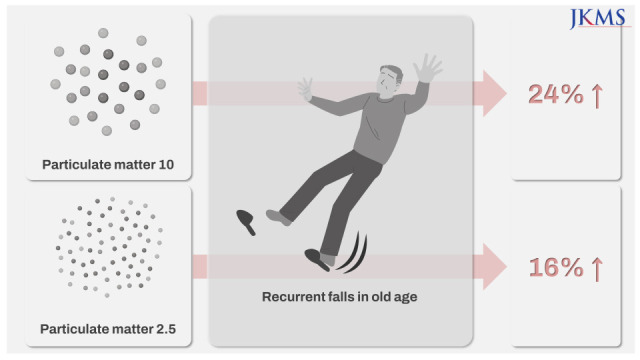
 XML Download
XML Download